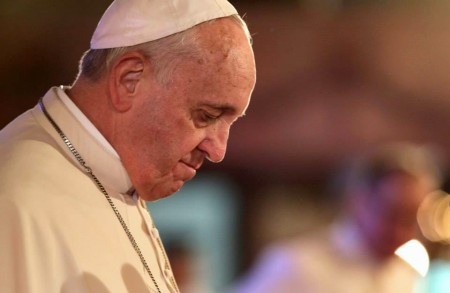Coming Boom won't be of Babies
FREE Catholic Classes
Long-Range Population Projections Keep Falling
NEW YORK, DEC. 20, 2003 (Zenit) - The Population Division of the U.N. Department of Economic and Social Affairs has published a long-range projection of world population in the year 2300. The study released Dec. 9 proposes a range of scenarios, based on projected fertility levels. Under the medium variant, considered the most probable, world population will rise from the current 6.3 billion to around 9 billion in 2300.
This projection assumes that fertility levels will eventually stabilize around 2.0 children per woman. The study was released to coincide with a gathering of population scientists at the U.N. Expert Group Meeting on World Population in 2300.
The low scenario of world population in 2300 assumes fertility of 1.85 children per woman, while the high scenario assumes fertility of 2.35 children per woman. This would lead to world population levels of 2.3 billion and 36.4 billion, respectively.
The Population Division was careful to point out that the projections are very tentative, given that even slight variations in the fertility levels could result in major changes in population levels. If fertility turns out to be just 2% lower than that of the medium-fertility scenario, for example, population size would stabilize around 8.3 billion.
The report continues the trend in recent years of a steady lowering of the U.N. population projections. The 9 billion level in the new long-range forecasts show a notably smaller future population size than previous long-range projections, calculated at 10-12 billion. According to the Population Division this is primarily due to the recent fertility declines occurring throughout the developing world. It expects this trend will continue.
Almost all the expected population increase between 2000 and 2300 will take place in the less developed regions. Their population is projected to rise from 4.9 billion in 2000 to 7.7 billion in 2300. In the developed regions, population will see only a slight change, from 1.2 billion in 2000 to 1.3 billion in 2300.
Shifts and aging
The medium-level projection also reveals major changes in the distribution of world population. Africa's share would nearly double, from 13% of the world population in 2003 to 24% in 2300. But Europe's share would be almost halved, from 12% to 7%. Asia's share could fall from its 61% level in 2000 to 55% in 2300.
In terms of individual countries, China, India and the United States will still be the most populous in the world. By 2050, India is expected to surpass China in population size and will remain the most populous country thereafter. Yet, the Big Three are expected to account for a declining share of the world population, passing from 43% in 2000 to about 35% in 2300.
Projections also forecast a dramatically older population. The world median age is expected to rise from 26 years today to nearly 50 years in 2300. Overall, the number of people aged 60 years or over would rise from the current 10% of world population, to 38% in 2300.
In developed regions, the share of those 60-or-over could more than double, from 19% in 2000 to 41% in 2300. In the developing countries the figure could more than quadruple, from 8% in 2000 to 37% in 2300.
The most notable change is for the group of people aged 80 or over, who will see their presence rise from just 1% today to 17%. At the opposite end of the spectrum, the share of those under age 15 will fall from 30% in 2000 to 16% by 2300.
This significant aging of world population would mean a large increase in the ratio of dependents (those under age 15 or over 59) to the population of working age (those aged 15 to 59). In the medium scenario, the world's dependency ratio rises from 0.7 in 2000 to 1.1 in 2300. This means there will be more than one dependent per person of working age.
Older first-time moms
New data confirm the U.N. projections. The average age at which women in the United States are having their first child has reached 25.1 years, the Associated Press reported Wednesday. A study released by the Centers for Disease Control and Prevention attributes this trend to a drop in teen births and an increase in the number of women who are putting off motherhood until their 30s and 40s. The average age for a first-time mom in 1970 was 21.4.
We ask you, humbly: don't scroll away.
Hi readers, it seems you use Catholic Online a lot; that's great! It's a little awkward to ask, but we need your help. If you have already donated, we sincerely thank you. We're not salespeople, but we depend on donations averaging $14.76 and fewer than 1% of readers give. If you donate just $5.00, the price of your coffee, Catholic Online School could keep thriving. Thank you.Help Now >
In Italy, the average age of a mother's first child is also on the increase, according to the national statistics body, ISTAT. In 2000 the age reached 30.4, compared with 27.5 in 1980, the newspaper Il Corriere della Sera reported Wednesday. The overall fertility level for women rose marginally, to 1.26 children per woman in 2002, compared with 1.25 the year before. But the increase still leaves fertility well below the level needed -- 2.2 children -- to avoid a decline in population levels.
In the United Kingdom, a recent report affirmed that the population will start to fall after 2040, the Observer newspaper reported Dec. 14. The prediction was made by the government's Actuary Department. Another forecast, made by Office of National Statistics, puts at about 22% the level of women choosing not to have children. According to the report, the average British woman married at 23 at the start of the 1980s, compared with just over 28 today.
Japan is also concerned about the lack of little ones. Its fertility rate is around 1.3 children per woman. But efforts by government authorities to stimulate births have failed, the Financial Times reported Dec. 10. Since the late 1990s, Japanese prefectures have organized hiking trips and cruises for singles in the hope of encouraging weddings. The results have been poor. One scheme in Shimane prefecture in western Japan cost $150,000 during three years, but only produced seven marriages and four babies.
Countries with historically high numbers of children are also facing notable declines in fertility. In Ireland the average number of children per family is down from 2.2 in 1986 to 1.6 in 2002, according to census figures reported June 20 in the Irish Independent. Cohabiting couples accounted for 8.4% of all family units last year, more than double the rate of six years earlier. And almost two-thirds of these couples were childless.
In Mexico, the national body in charge of demographic matters, Conapo, has warned of coming problems due to the aging of the country's population. The sector of those aged 65 or over is now only 5% of the population; that figure could rise to 25% by 2050, the newspaper El Heraldo de México reported May 25.
The quintupling of this group represents a radical break with the past. In 1930 the 65-plus age group counted for 3% of the population. It took another four decades to reach 4.3%. From 1970 to now it only rose by 0.7%. The major increase in the elderly population expected in coming decades is due to a combination of an increase in life expectancy and a sharp decrease in fertility. A population boom is indeed on the way, among the elderly.
Contact
Catholic Online
https://www.catholic.org
CA, US
Catholic Online - Publisher, 661 869-1000
info@yourcatholicvoice.org
Keywords
Population, Family, Babies, Economic, Social
 Hi readers, it seems you use Catholic Online a lot; that's great! It's a little awkward to ask, but we need your help. If you have already donated, we sincerely thank you. We're not salespeople, but we depend on donations averaging $14.76 and fewer than 1% of readers give. If you donate just $5.00, the price of your coffee, Catholic Online School could keep thriving. Thank you. Help Now >
Hi readers, it seems you use Catholic Online a lot; that's great! It's a little awkward to ask, but we need your help. If you have already donated, we sincerely thank you. We're not salespeople, but we depend on donations averaging $14.76 and fewer than 1% of readers give. If you donate just $5.00, the price of your coffee, Catholic Online School could keep thriving. Thank you. Help Now >
More Catholic PRWire
Showing 1 - 50 of 4,716
A Recession Antidote
Randy Hain
Monaco & The Vatican: Monaco's Grace Kelly Exhibit to Rome--A Review of Monegasque-Holy See Diplomatic History
Dna. Maria St. Catherine Sharpe, t.o.s.m., T.O.SS.T.
The Why of Jesus' Death: A Pauline Perspective
Jerom Paul
A Royal Betrayal: Catholic Monaco Liberalizes Abortion
Dna. Maria St.Catherine De Grace Sharpe, t.o.s.m., T.O.SS.T.
Embrace every moment as sacred time
Mary Regina Morrell
My Dad
JoMarie Grinkiewicz
Letting go is simple wisdom with divine potential
Mary Regina Morrell
Father Lombardi's Address on Catholic Media
Catholic Online
Pope's Words to Pontifical Latin American College
Catholic Online
Prelate: Genetics Needs a Conscience
Catholic Online
State Aid for Catholic Schools: Help or Hindrance?
Catholic Online
Scorsese Planning Movie on Japanese Martyrs
Catholic Online
2 Nuns Kidnapped in Kenya Set Free
Catholic Online
Holy See-Israel Negotiation Moves Forward
Catholic Online
Franchising to Evangelize
Catholic Online
Catholics Decry Anti-Christianity in Israel
Catholic Online
Pope and Gordon Brown Meet About Development Aid
Catholic Online
Pontiff Backs Latin America's Continental Mission
Catholic Online
Cardinal Warns Against Anti-Catholic Education
Catholic Online
Full Circle
Robert Gieb
Three words to a deeper faith
Paul Sposite
Relections for Lent 2009
chris anthony
Wisdom lies beyond the surface of life
Mary Regina Morrell
World Food Program Director on Lent
Catholic Online
Moral Clarity
DAN SHEA
Pope's Lenten Message for 2009
Catholic Online
A Prayer for Monaco: Remembering the Faith Legacy of Prince Rainier III & Princess Grace and Contemplating the Moral Challenges of Prince Albert II
Dna. Maria St. Catherine Sharpe
Keeping a Lid on Permissiveness
Sally Connolly
Glimpse of Me
Sarah Reinhard
The 3 stages of life
Michele Szekely
Sex and the Married Woman
Cheryl Dickow
A Catholic Woman Returns to the Church
Cheryl Dickow
Modernity & Morality
Dan Shea
Just a Minute
Sarah Reinhard
Catholic identity ... triumphant reemergence!
Hugh McNichol
Edging God Out
Paul Sposite
Burying a St. Joseph Statue
Cheryl Dickow
George Bush Speaks on Papal Visit
Catholic Online
Sometimes moving forward means moving the canoe
Mary Regina Morrell
Action Changes Things: Teaching our Kids about Community Service
Lisa Hendey
Easter... A Way of Life
Paul Spoisite
Papal initiative...peace and harmony!
Hugh McNichol
Proclaim the mysteries of the Resurrection!
Hugh McNichol
Jerusalem Patriarch's Easter Message
Catholic Online
Good Friday Sermon of Father Cantalamessa
Catholic Online
Papal Address at the End of the Way of the Cross
Catholic Online
Cardinal Zen's Meditations for Via Crucis
Catholic Online
Interview With Vatican Aide on Jewish-Catholic Relations
Catholic Online
Pope Benedict XVI On the Easter Triduum
Catholic Online
Holy Saturday...anticipation!
Hugh McNichol











 Daily Readings for Friday, April 19, 2024
Daily Readings for Friday, April 19, 2024 St. Alphege: Saint of the Day for Friday, April 19, 2024
St. Alphege: Saint of the Day for Friday, April 19, 2024 Stewardship Prayer: Prayer of the Day for Friday, April 19, 2024
Stewardship Prayer: Prayer of the Day for Friday, April 19, 2024

